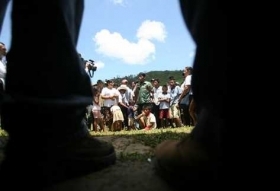Violence driven by organized crime in Mexico and Central America has forced thousands from their homes, with some fleeing over the U.S.’s southern border in what could be a new challenge for migration authorities.
The increase in Mexican “narco-refugees” is the subject of a new report from the Strategic Studies Institute, an academic offshoot of the U.S. Army. As author Paul Rexton Kan argues, the rising number of Mexicans seeking asylum reflects a rapidly changing environment in Mexico, and has the potential to create a serious set of headaches for U.S. policy-makers:
If the health of the Mexican state declines because criminal violence continues, increases, or spreads, U.S. communities will feel an even greater burden on their systems of public safety and public health from narco-refugees. Given the ever-increasing brutality of the cartels, the question is whether and how the U.S. Government should begin to prepare for what could be a new wave of migrants coming from Mexico.
[…]
Yet, the lack of a clear U.S. policy on what to do about narco-refugees from Mexico mirrors the complicated U.S. relationship with Mexico itself, thus compounding the complication.
According to the report, roughly 2,500 Mexicans used violence as the basis for an appeal for asylum in the U.S. in 2008, an almost 50-fold increase from 2006, when President Felipe Calderon took office. Other reports differ with regard to the size of the increase — Global Post says that more than 2,600 requested asylum as early as 2006 — but most sources suggest that several thousand people are requesting asylum annually. Additionally, many thousands more are using alternative means of entry into the U.S. to escape the violence, from tourist visas to legal residencies for investors.
The report focuses primarily on the challenge coming from those looking to escape Mexico for the U.S., but outbreaks in drug violence have also spurred migration within Mexico. In all, the Internal Displacement Monitoring Centre (IDMC) estimates that 230,000 Mexicans qualify as displaced.
Of course, it can be difficult to distinguish between forcible displacement and voluntary migration, and some studies offer a more worrying picture. According to data provided by Inegi, Mexico’s statistical agency, in 2010, the population in the embattled northern city of Juarez declined from 1.3 million to roughly 1 million in just two years. Another study released around the same time from the Autonomous University of Ciudad Juarez (UACJ, for its initials in Spanish) estimated the size of the population loss at 500,000. According to a further study by UACJ, 33,000 homes in the city are unoccupied.
In Monterrey, the wealthy northern metropolis previously considered Mexico’s safest big city, rising violence has helped scare people off. An anonymous source recently told journalist Jorge Zepeda Patterson that the number of students at the prestigious Tec de Monterrey, a mega-campus that has served as a significant draw to the area, has dropped by more than 25 percent in the past year and a half.
The problem is not limited to Mexico; in the northern half of Central America, where the violence is far more severe than in Mexico, residents have also been driven from their homes. In September, for instance, an anti-drug operation in the north Guatemalan province of Peten sent more than 90 families scrambling across the border to Mexico. As InSight Crime reported, the residents of the village of Nueva Esperanza said that government security forces accused them of trafficking drugs, a charge they denied, and then burned their homes.
The relatively limited extent of displacement is one element that separates the current security travails in Central America and Mexico from the country with which they are most often compared: Colombia. In the South American nation, where the government’s loss of territory has been more severe, and where the presence of leftist rebels and right-wing paramilitaries heightened the situation, making it far more politically charged and complicated for civilians, there has been mass displacement from many areas of the country and migration into the cities. The IDMC says that more than 5 million people have been displaced in Colombia, amounting to more than 10 percent of the population, compared to just over 0.2 percent in Mexico.

